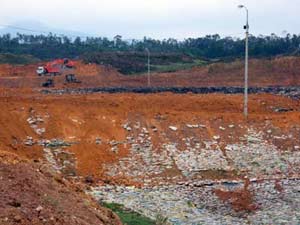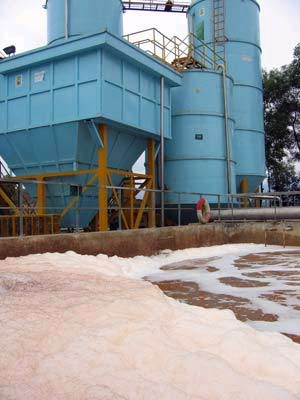Urban areas and industrial zones discharge approximately 3,110,000 m3 of domestic and industrial wastewater directly into surface water sources every day.
According to information from the Department of Environmental Protection (Ministry of Natural Resources and Environment), the system of ponds, lakes, canals, and ditches in major cities is severely polluted, exceeding permissible standards by 5 to 10 times; most lakes in urban areas of large cities (Hanoi, Ho Chi Minh City, Hai Phong, Hue) are still in a state of eutrophication, with many lakes experiencing sudden eutrophication and organic contamination.
Urban Areas: Overwhelmed by Wastewater
 |
|
Nam Son Waste Treatment Area, Hanoi |
Furthermore, the concentration of pollutants (COD, total nitrogen, total phosphorus, and heavy metals) in landfills or waste disposal sites is very high, and leachate is often heavily colored. When released into the environment, leachate can severely pollute both surface water and surrounding groundwater.
Alongside the aforementioned waste, approximately 1,000 hospitals and healthcare centers (at the district level) discharge hundreds of thousands of m3 of untreated wastewater daily, which does not meet environmental standards. This wastewater contains many hazardous components, causing serious environmental pollution.
Moreover, the annual amount of pesticides used in agriculture is about 0.5-3.5 kg/ha/season, along with the use of pesticides and mineral fertilizers in production activities, which also contributes to water eutrophication or contamination. Around 1,450 craft villages contribute a significant amount of waste to the environment, severely polluting many areas, especially in paper production, livestock slaughter, and dyeing industries.
Specifically, in Hanoi, the total amount of domestic wastewater discharged daily is approximately 450,000 m3; wastewater from production and service establishments discharges into the city’s drainage system is about 260,000 m3; the rivers within Hanoi have become polluted, especially the wastewater drainage rivers like Kim Nguu and To Lich, which can no longer self-purify. The water quality of urban lakes also fails to meet Class B standards due to organic pollution.
Ho Chi Minh City, with about 1,000 industrial establishments and over 22,000 small industrial production facilities, many of which do not have wastewater treatment systems, leads to pollution of surface water by organic materials and microorganisms.
Waterway transport activities also contribute to oil pollution and acidification in the Saigon River and Dong Nai River, alongside issues from land reclamation and the use of acidic mineral fertilizers. The pollution level in the Saigon River tends to increase downstream.
In other cities (Hai Phong, Hue, Ha Long, Vinh), no rivers meet Class A standards.
Wastewater Treatment Not Meeting Urban Development Requirements
 |
|
Advanced Waste Treatment Technology |
According to the Department of Environmental Protection, Vietnam currently does not have any landfills equipped with leachate treatment systems that meet environmental standards according to Vietnamese standard 5945-1995.
Meanwhile, among the 76 industrial parks (IPs) and export processing zones currently in operation, only 16 centralized wastewater treatment stations are operational, with a capacity of 41,800 m3 per day. The wastewater treatment technology primarily involves biological or chemical methods combined with biological processes. The amount of industrial wastewater treated to meet environmental standards is still very low (4.26%).
Dr. Hoang Duong Tung from the Department of Environmental Protection stated that currently, only a few cities like Hanoi, Ho Chi Minh City, Da Nang, Ha Long… have wastewater treatment stations of various types with capacities over 5,000 m3 per day in the design and construction phase, with none yet operational. Some other cities and towns are also developing urban wastewater treatment projects funded by international organizations and projects.
As mentioned, wastewater treatment efforts have not been intensified; some urban areas have constructed localized wastewater treatment stations for hospitals (Hanoi, Hai Phong, Quang Ninh, Hue, Da Nang…), but due to various reasons such as design, operation, maintenance, and lack of funding, many stations have deteriorated and ceased operations after a short period.
For concentrated industrial zones, regulations require the construction of wastewater treatment stations that comply with TCVN 5945-95, but these industrial zones have built very limited centralized collection and treatment systems; the wastewater treatment stations also operate intermittently, are often just for show, and have low treatment quality.
Deputy Director of the Urban Technical Infrastructure Department Bui Xuan Doan believes that it is necessary to implement a unified planning for drainage and wastewater treatment in large urban areas by establishing construction plans for the Hanoi Capital Region,
the Ho Chi Minh City Region, and key economic areas, as well as planning provincial regions for provinces without existing plans. This should focus on researching and applying scientific and technological advancements, using advanced wastewater treatment technologies suitable for Vietnam’s economic development conditions; mobilizing domestic funding and ODA to invest in building drainage and wastewater treatment systems.
Kieu Minh


















































